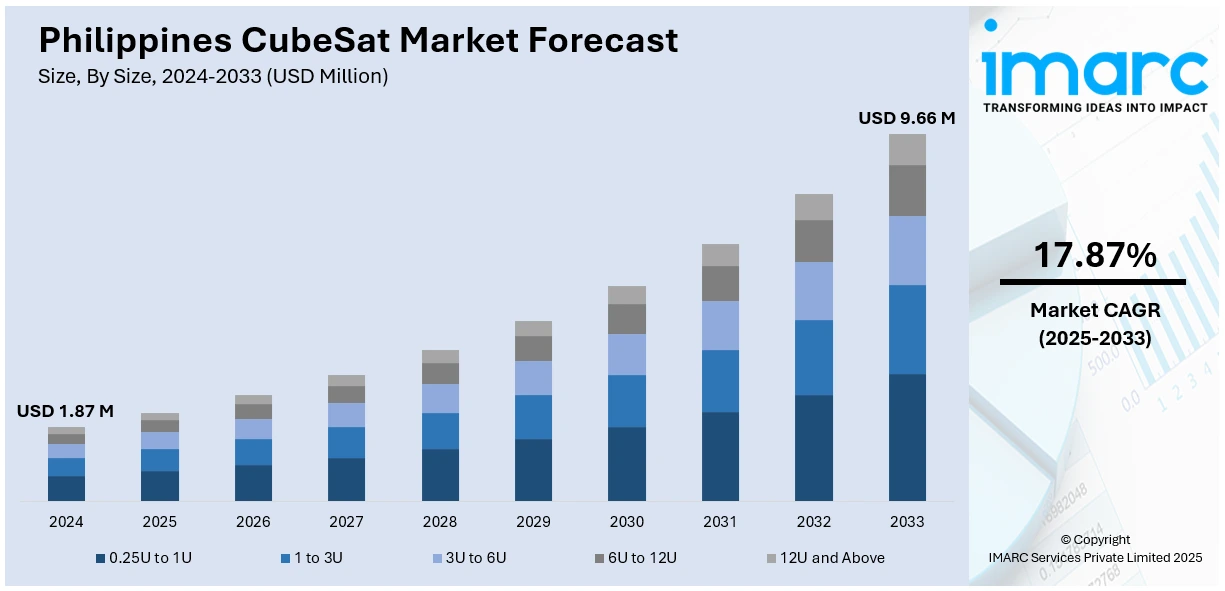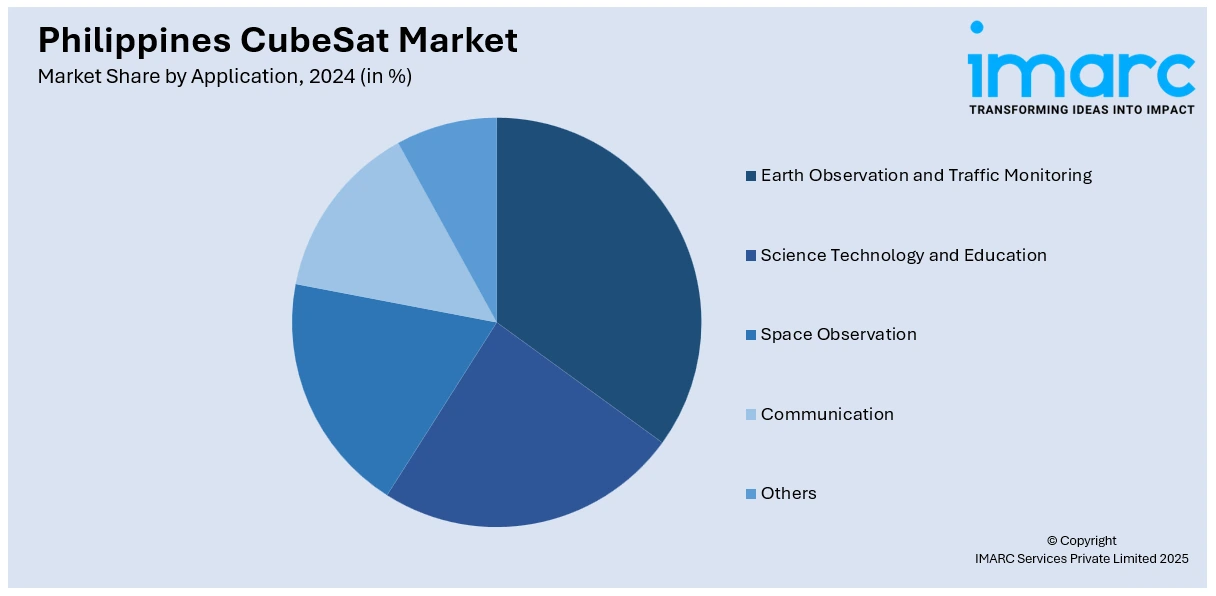
Philippines CubeSat Market Size, Share, Trends and Forecast by Size, Application, End User, Subsystem, and Region, 2025-2033
Philippines CubeSat Market Overview:
The Philippines CubeSat market size reached USD 1.87 Million in 2024. The market is projected to reach USD 9.66 Million by 2033, exhibiting a growth rate (CAGR) of 17.87% during 2025-2033. Growing satellite deployment for communication and earth observation, rising demand for space-based research, and government support through space programs are some of the factors contributing to the Philippines CubeSat market share. Expanding academic partnerships, affordability of small satellites, and regional security needs further encourage investments and adoption across sectors.
|
Report Attribute
|
Key Statistics
|
|---|---|
|
Base Year
|
2024
|
|
Forecast Years
|
2025-2033
|
|
Historical Years
|
2019-2024
|
| Market Size in 2024 | USD 1.87 Million |
| Market Forecast in 2033 | USD 9.66 Million |
| Market Growth Rate 2025-2033 | 17.87% |
Philippines CubeSat Market Trends:
Academic and Government-Backed CubeSat Programs
One major trend in the Philippines CubeSat market is the growing importance of academic institutions and government backing in space technology advancements. Universities including the University of the Philippines and Mapúa Institute of Technology have worked with the Philippine Space Agency (PhilSA) to create and launch CubeSats for Earth observation, environmental monitoring, and disaster response. Small satellites, according to the government, are a cost-effective approach to expand national space scientific capabilities without requiring substantial investments. These projects have sparked international collaboration, notably with Japan and the United States, which give technical knowledge, launch possibilities, and finance assistance. This drive has also encouraged more students and researchers to study aeronautical engineering, therefore increasing the local talent pipeline. Over time, this academic-government collaboration has created a foundation for long-term space capability, allowing the Philippines to position itself as a participant in the global small satellite market while also addressing domestic needs like agriculture monitoring, disaster preparedness, and climate research. These factors are intensifying the Philippines CubeSat market growth.

To get more information on this market, Request Sample
Commercialization and Startup Participation
Another trend is the growing involvement of private companies and startups in the CubeSat market in the Philippines. As the global demand for affordable satellite-based services expands, Filipino entrepreneurs are exploring CubeSat applications in telecommunications, precision agriculture, maritime monitoring, and logistics. Some startups are pursuing partnerships with international satellite service providers to integrate local applications with global networks, reducing costs and accelerating deployment. The private sector’s interest is fueled by falling launch costs through rideshare missions and the availability of standardized CubeSat components, which lower entry barriers for new players. This commercialization wave is also linked to the country’s expanding digital economy, where CubeSat-enabled services can support connectivity in remote areas, enhance disaster recovery solutions, and provide real-time data for businesses. Venture capital interest is still at an early stage, but small-scale investments and incubator programs are starting to appear, particularly in Manila. If sustained, this commercialization trend could complement government-led efforts, creating a dual-track market where academic research drives innovation while startups convert it into revenue-generating services.
Philippines CubeSat Market Segmentation:
IMARC Group provides an analysis of the key trends in each segment of the market, along with forecasts at the country and regional level for 2025-2033. Our report has categorized the market based on size, application, type, and subsystem.
Size Insights:
- 0.25U to 1U
- 1 to 3U
- 3U to 6U
- 6U to 12U
- 12U and Above
The report has provided a detailed breakup and analysis of the market based on the size. This includes 0.25U to 1U, 1 to 3U, 3U to 6U, 6U to 12U, and 12U and above.
Application Insights:

- Earth Observation and Traffic Monitoring
- Science Technology and Education
- Space Observation
- Communication
- Others
The report has provided a detailed breakup and analysis of the market based on the application. This includes earth observation and traffic monitoring, science technology and education, space observation, communication, and others.
End User Insights:
- Government and Military
- Commercial
- Others
The report has provided a detailed breakup and analysis of the market based on the end user. This includes government and military, commercial, and others.
Subsystem Insights:
- Payloads
- Structures
- Electrical Power Systems
- Command and Data Handling
- Propulsion Systems
- Attitude Determination and Control Systems
- Others
The report has provided a detailed breakup and analysis of the market based on the subsystem. This includes payloads, structures, electrical power systems, command and data handling, propulsion systems, attitude determination and control systems, and others.
Regional Insights:
- Luzon
- Visayas
- Mindanao
The report has also provided a comprehensive analysis of all the major regional markets, which include Luzon, Visayas, and Mindanao.
Competitive Landscape:
The market research report has also provided a comprehensive analysis of the competitive landscape. Competitive analysis such as market structure, key player positioning, top winning strategies, competitive dashboard, and company evaluation quadrant has been covered in the report. Also, detailed profiles of all major companies have been provided.
Philippines CubeSat Market Report Coverage:
| Report Features | Details |
|---|---|
| Base Year of the Analysis | 2024 |
| Historical Period | 2019-2024 |
| Forecast Period | 2025-2033 |
| Units | Million USD |
| Scope of the Report |
Exploration of Historical Trends and Market Outlook, Industry Catalysts and Challenges, Segment-Wise Historical and Future Market Assessment:
|
| Sizes Covered | 0.25U to 1U, 1 to 3U, 3U to 6U, 6U to 12U, 12U and Above |
| Applications Covered | Earth Observation and Traffic Monitoring, Science Technology and Education, Space Observation, Communication, Others |
| End Users Covered | Government and Military, Commercial, Others |
| Subsystems Covered | Payloads, Structures, Electrical Power Systems, Command and Data Handling, Propulsion Systems, Attitude Determination and Control Systems, Others |
| Regions Covered | Luzon, Visayas, Mindanao |
| Customization Scope | 10% Free Customization |
| Post-Sale Analyst Support | 10-12 Weeks |
| Delivery Format | PDF and Excel through Email (We can also provide the editable version of the report in PPT/Word format on special request) |
Key Questions Answered in This Report:
- How has the Philippines CubeSat market performed so far and how will it perform in the coming years?
- What is the breakup of the Philippines CubeSat market on the basis of size?
- What is the breakup of the Philippines CubeSat market on the basis of application?
- What is the breakup of the Philippines CubeSat market on the basis of end user?
- What is the breakup of the Philippines CubeSat market on the basis of subsystem?
- What is the breakup of the Philippines CubeSat market on the basis of region?
- What are the various stages in the value chain of the Philippines CubeSat market?
- What are the key driving factors and challenges in the Philippines CubeSat market?
- What is the structure of the Philippines CubeSat market and who are the key players?
- What is the degree of competition in the Philippines CubeSat market?
Key Benefits for Stakeholders:
- IMARC’s industry report offers a comprehensive quantitative analysis of various market segments, historical and current market trends, market forecasts, and dynamics of the Philippines CubeSat market from 2019-2033.
- The research report provides the latest information on the market drivers, challenges, and opportunities in the Philippines CubeSat market.
- Porter's Five Forces analysis assists stakeholders in assessing the impact of new entrants, competitive rivalry, supplier power, buyer power, and the threat of substitution. It helps stakeholders to analyze the level of competition within the Philippines CubeSat industry and its attractiveness.
- Competitive landscape allows stakeholders to understand their competitive environment and provides an insight into the current positions of key players in the market.
Need more help?
- Speak to our experienced analysts for insights on the current market scenarios.
- Include additional segments and countries to customize the report as per your requirement.
- Gain an unparalleled competitive advantage in your domain by understanding how to utilize the report and positively impacting your operations and revenue.
- For further assistance, please connect with our analysts.
 Request Customization
Request Customization
 Speak to an Analyst
Speak to an Analyst
 Request Brochure
Request Brochure
 Inquire Before Buying
Inquire Before Buying




.webp)




.webp)












